Web Development Simplified: Leading Python Web Frameworks
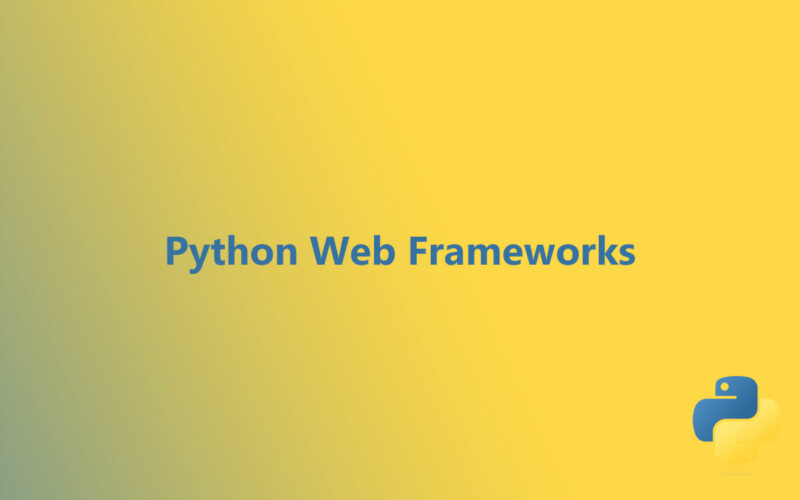
Imagine molding the digital cosmos with nothing but your ideas and lines of code. Welcome to the world of Python web frameworks—the sculptor’s clay of the internet.
Each stroke of the keyboard can carve pathways for data, frame the expanse of a user interface, or chisel the intricate details of backend logic.
Here, efficiency meets eloquence. This is where the architecture that underpins the most visited sites begins. It’s an artisan’s domain, fashioning scalable Python applications and RESTful APIs with a mere flourish.
In this read, embark on a voyage through Python’s cadre of frameworks. You’ll navigate the likes of Django, renowned for its all-in-one convenience, and Flask, celebrated for its precision. Like the hidden framework of majestic cathedrals, these tools support the ever-expanding web.
By the end, you’ll not only grasp how to select the one suited to your task but also deploy Python backend development and building REST API in Python with finesse. This article unveils the templating engines and threading secrets that will elevate your web presence like never before.
Python Web Frameworks
| Python Web Framework | Maturity | Type/Style | Main Features | Use case/Popularity |
|---|---|---|---|---|
| Django | Mature | Full-stack | ORM, Admin Panel, Scalability, Security, REST framework | Widely used for diverse types of web applications; large community |
| Zope | Mature | Full-stack | Object database, Web server, Component architecture | Suited for large and complex web apps; not as popular currently |
| Pylons Project | Mature | Full-stack | Modular design, WSGI compliance, Multiple data storage options | Used in Pyramid framework; legacy projects |
| Flask | Mature | Microframework | Minimalist, Extensible, Large ecosystem of extensions | Ideal for small to medium applications, simple and flexible |
| Grok | Moderate | Full-stack | Convention over configuration, Built on Zope Toolkit | Good for rapid development; lesser-known |
| Jam.py | Moderate | RAD-tool, Microframework | Quickly develop database-driven applications, GUI Builder | Rapid development of data-driven apps; small community |
| Nevow | Experienced | Microframework | Templating engine (Stan), Components (Athena) | Focus on web apps with custom behaviour; diminished popularity |
| FastAPI | Growing | Microframework | Async support, Type hints, API validation, OpenAPI/Swagger | Fast development for modern web APIs; highly performant |
| TurboGears | Mature | Full-stack | MVC framework, Multi-database support, Command-line tools | For those preferring an all-in-one solution; smaller community |
| Quixote | Moderate | Microframework | Template-free, Compile templates to byte code | Suited for small-scale web apps; narrow user base |
| web2py | Mature | Full-stack | No config, built-in components, Database abstraction layer | Good for beginners and rapid development; waning popularity |
| CherryPy | Mature | Object-oriented microframework | Embedded multi-threaded server, Plugin system | Minimalist approach, suited for object-oriented web apps |
| Phalcon | Growing | Full-stack | C extension, High performance, Low-level architecture, ORM | For high-speed performance needs; unique as a compiled framework |
Django
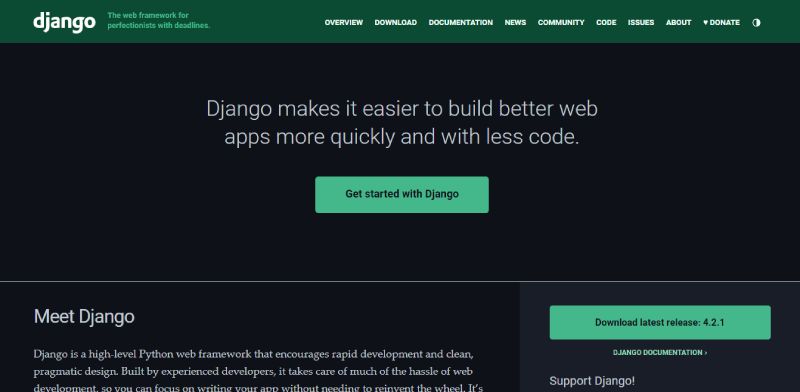
Django releases the reins of rapid development into the hands of the creator. It’s the go-to Python web framework for perfectionists with deadlines, merging pragmatism with a myriad of functionalities. Fortified with an ORM, Django administers database integration like a master conductor guiding an orchestra. The framework is tailored for full-stack Python development, sculpting everything from the data models to the final stroke of CSS perfection.
Best Features:
- Admin Interface
- Scalability
- Security
What we like about it: Django’s ORM—a powerful magician in handling database queries—crafts a seamless waltz between objects and database tables.
Zope
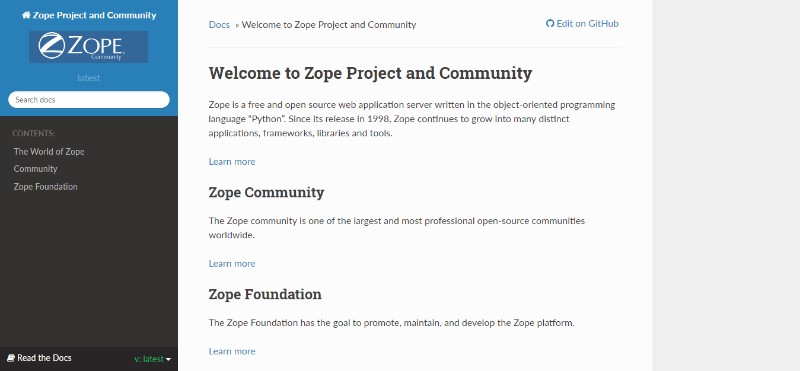
Zope is the elder sage of Python web frameworks, pioneering the move towards reusable components called ‘Objects’. This framework is where scalable Python applications find a harbor with its robust transaction management and object database. It’s a versatile tool that builds a bridge between the complex backend operations and elegant web interfaces.
Best Features:
- Object-Oriented
- Built-in Security
- ZODB (Zope Object Database)
What we like about it: Zope’s transactional object database (ZODB) shines, cutting through the usual SQL database noise, making data persistence feel almost ethereal.
Pylons Project
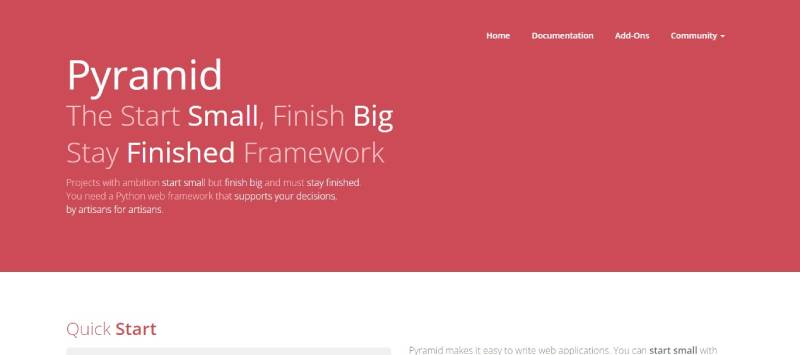
Emerging from the union of Pylons and Pyramid web frameworks, this project offers a versatile option for Python MVC architecture enthusiasts. Embrace the templating engines and WSGI support it wields to design applications with fidelity. The Pylons Project provides a scaffold to construct intricate web solutions, prizing clarity and convention in equal measure.
Best Features:
- Flexibility
- Functionality
- Speed
What we like about it: Its perfect balance of flexibility and control, supporting rapid application development without sacrificing power.
Flask
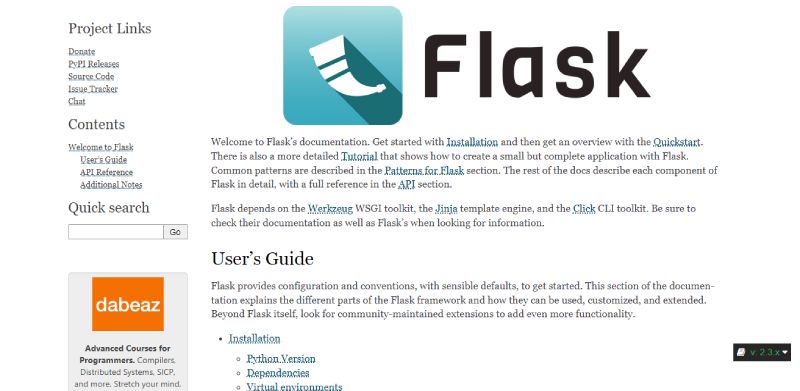
Flask is an esteemed architect’s chisel, offering backend development precision in a lightweight package. The micro web framework is favored by artisans who prefer bare-bones simplicity, extensible to one’s content. It encourages the application to blossom organically without imposing heavyweight structures.
Best Features:
- Modularity
- Flexibility
- Ease of Use
What we like about it: Flask’s microframework nature is a canvas for unadulterated creativity, championing freedom over rigidity.
Jam.py
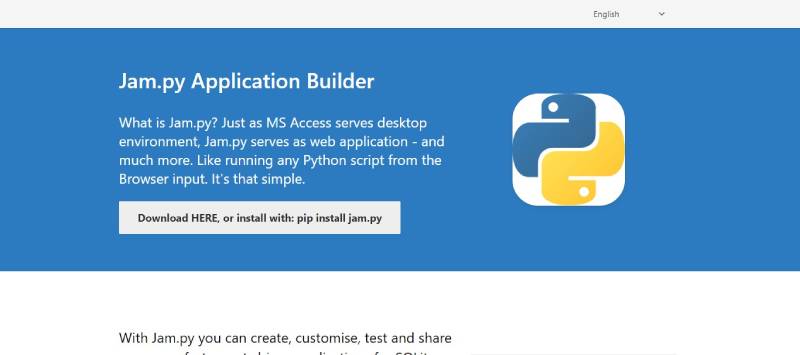
Crafting database-driven applications becomes a breeze with Jam.py. Its fortitude lies in turning data into highly functional web apps. With the Python web framework guiding the way, CRUD operations, reporting, and workflow processes are tailored with straightforward efficiency. Aim for it when the project demands focused data management gymnastics.
Best Features:
- Rich API
- Visual Designer
- Data-Driven
What we like about it: Its visual editor stands out, proving a boon for designing the data structures and UI simultaneously.
FastAPI
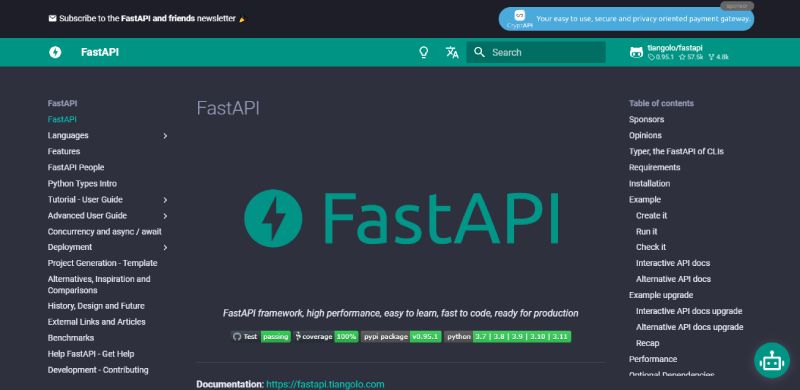
FastAPI stands as a rapid gunslinger in the world of Python backend development, firing on all cylinders in unison with modern web standards. It is famed for its impressive speed and ease in crafting stellar RESTful APIs. With automatic validation and interactive documentation, it swiftly rallies to the call of API development.
Best Features:
- Speed
- Type checking and Validation
- OpenAPI and JSON Schema standards
What we like about it: Automatic API documentation generation is the headliner here—simplifying API exploration and interaction.
TurboGears
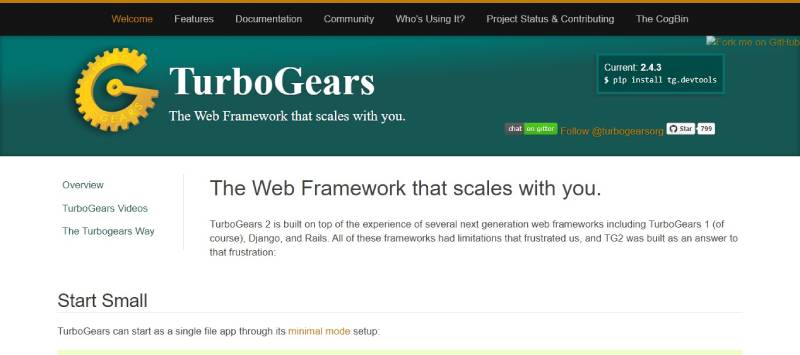
TurboGears picks up the speed where others take measured strides. It is an all-in-one full-stack solution, engineered for scalable Python applications that start as a spark and expand into raging infernos. It bundles MVC framework, ORM, and templating engines—a complete package for full-stack development.
Best Features:
- Multi-database support
- MVC Architecture
- Command-line tools
What we like about it: The integration of multiple databases and powerful ORM tools under one hood makes database management a sophisticated affair.
Quixote
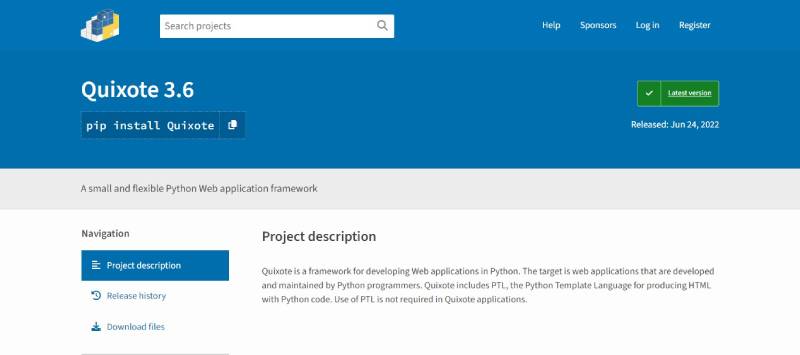
Quixote is the unsung hero among Python web frameworks, taking an unconventional approach to crafting web applications. It emphasizes on clarity and simplicity, with an aversion to excess fluff. Designed for developers who relish hand-coding their HTML, it focuses on delivering unadulterated control for web artisans.
Best Features:
- Simplicity
- Flexibility
- Customizable
What we like about it: The direct and clear-cut way in which it allows developers to manage their HTML-generation code.
web2py
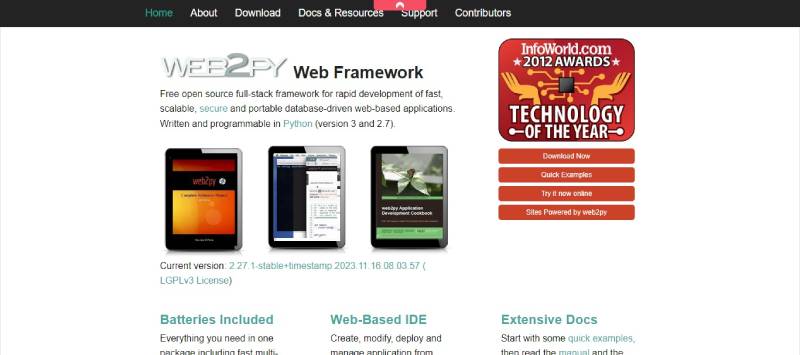
Web2py sails the Python web frameworks ocean with a pledge of no-installation and a web-based Integrated Development Environment. It’s a smooth journey from concept to clickable web application, replete with database integration, session management, and security. Its spectrum of tools bestows web smiths the means to forge intricate online applications.
Best Features:
- Ease of setup
- Built-in components
- Web-based IDE
What we like about it: The convenience of a web IDE allowing developers to design, develop, deploy, and debug, all within the browser.
CherryPy
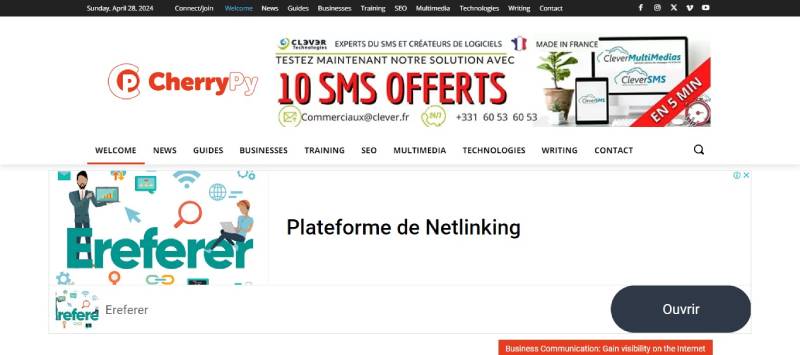
CherryPy operates under the guise of simplicity while holding a torch to object-oriented programming within the Python community. It is a minimalist framework—no bigger than a microframework—but with the resilience of a heavyweight. It champions a plug-in system and a myriad of tools, ushering lightweight web applications to life.
Best Features:
- Simplicity
- Extensibility
- Embeddable
What we like about it: Its built-in tools for caching, encoding, sessions, authentication, and static content are a precise foundation for Python web services.
Phalcon
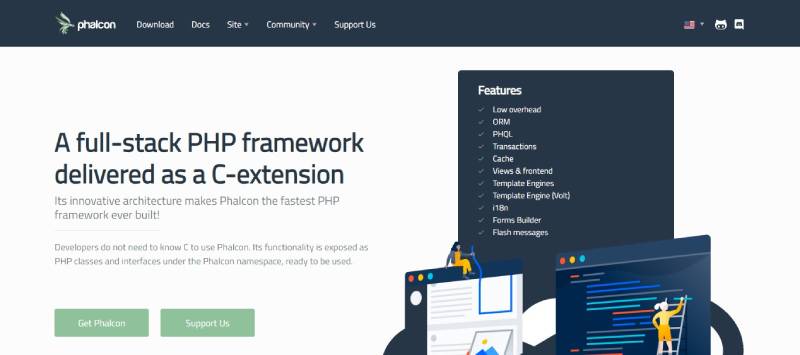
Kindly note, Phalcon is not a Python framework, but rather a framework implemented as a C-extension for PHP. It’s revered for its jaw-dropping speed and gentle resource consumption. Seizing maximum efficiency, it is best suited for developers intertwined with the PHP language and seeking performance that soars.
Best Features:
- Speed
- Low Memory Consumption
- Full-Stack
What we like about it: Its blistering velocity due to the C-extension underpinning sets a scorching benchmark for performance in web development.
FAQ On Python Web Frameworks
Which Python Web Framework Should I Start With?
Jumpstarting your journey, Django often takes the spotlight for beginners. Its robust „batteries included“ philosophy means you hit the ground running. Yet, the simplicity of Flask beckons those who yearn for minimalist design, laying bare the essentials of web crafting.
How Does Django Compare to Flask?
Django dons the mantle of the full-stack gladiator, armed to the teeth with features for a heavyweight bout. Contrastingly, Flask steps in as the nimble fencer, swift, with an edge for the precise strike. Django’s the all-in-one; Flask’s the “build as you go”.
Can I Build a RESTful API with Python Web Frameworks?
Indeed, FastAPI and Flask whisper the sweetest nothings for RESTful pursuits. FastAPI, with its lightning strikes of speed, is tailormade for API construction. Flask, ever versatile, meets API tasks head-on with extensions galore.
What Is Asynchronous Support in Python Web Frameworks?
Asynchronous support is the wizardry allowing simultaneous processes without the dreaded deadlock. Frameworks like Sanic and Aiohttp cast spells that keep your application spry, dealing with multiple requests in a blink—ideal for real-time, high-concurrency challenges.
Do Python Web Frameworks Handle Security Well?
Like a fortress with layers of defenses, frameworks like Django come well-equipped with shields against the dark arts: XSS, CSRF, and SQL Injection. Flask, when enhanced with the right extensions, stands sturdy too. But remember, the best defense is a well-informed smith.
How Easy Are Python Web Frameworks to Learn?
Python’s creed speaks of clarity and simplicity. Each framework embodies this, with Django presenting a structured path, and Flask, a gentle incline. Both beckon with open arms to the earnest learner, promising a rewarding ascent.
What Are Microframeworks in the Context of Python?
Microframeworks, the artisan’s pocket tools, excel in sculpting simple, single-purpose applications. Flask emerges as a poster child here, championing lightweight framework design and giving you just enough to carve out your niche applications with deft precision.
Can Python Web Frameworks Scale with My Application?
Indeed, they scale as the ivy climbs the garden wall. Frameworks like Django and Pyramid are inherently designed to expand gracefully with your growing needs, accommodating burgeoning traffic with ease.
Are Python Web Frameworks Suitable for Enterprise-Level Applications?
Fortune 500 tales abound of enterprises built on frameworks like Django and Pyramid. These frameworks’ stability and feature-rich ecosystems make them a trusted choice for applications at enterprise scale.
How Do I Choose Between Synchronous and Asynchronous Frameworks?
Contemplate the nature of your application. If real-time interactions weave through it, then an asynchronous chariot awaits—think Sanic or Aiohttp. For the synchronous path, Django and Flask stand tall, robust enough for most web endeavors. Your quest’s nature beckons the fitting framework.
Conclusion
Venturing through the landscape that Python web frameworks offer is akin to exploring a vast metropolis teeming with diverse architectures. Each district—from Flask’s minimalist avenues to Django’s bustling cityscape—offers distinct pathways to erecting structures in the web’s skyline.
With each framework, the power to innovate rests at our fingertips. Spellbinding capabilities allow for crafting secure web apps, emboldening visions with scalable Python applications, and stitching together RESTful APIs with seamless efficiency.
- Embrace Django for its out-of-the-box thoroughfare, ushering the robust features needed for elaborate design.
- Choose Flask to chart customized routes, relishing each feature added with precision.
- Let FastAPI accelerate your journey as you streamline into the modern era of async and await.
Here marks the crossroad, teeming with potentialities. Harness these formidable tools, and the web’s vast expanse becomes not a daunting frontier but a canvas, awaiting the strokes of innovation and creativity.
If you liked this article about Python web frameworks, you should check out these articles also:
- Math Made Easy: Best Apps Like PhotoMath
- Photo Enhancement: Must-Try Apps Like Lensa
- Organize Your Thoughts with Apps Like Notion
- Understanding JavaScript Array.length for Data Handling - June 26, 2024
- Red Flags to Watch for When Hiring an Affordable Website Design Agency - June 26, 2024
- How Flutter Enhances Video App Creation Across Platforms - June 26, 2024








